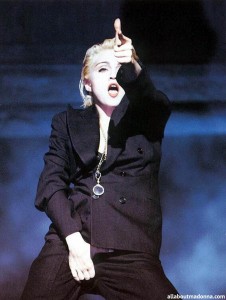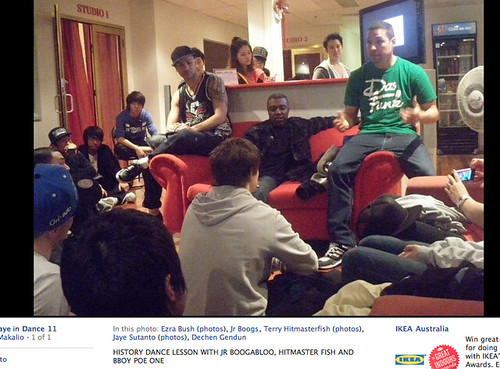
This is the theme song for this post.
Bug’s Question Of the Day is a regular thread on Faceplant (just search for ‘Bug’s question of the day’ over there). I keep typing replies and then deleting them. I want to engage, but sometimes my responses are too long or too hardcore or too stroppy for that sort of public talk. Over here, I figure I can write my replies and keep them within the context of my blog and broader thinking about dance and DJing and gender and stuff.
So here’s today’s question:
“When pulsing with an off-beat newbie as a follow, in what circumstances should one purely follow the lead versus trying to nudge the pulse towards the music with one’s own pulse? Is there a dance etiquette associated with this?”
There are various responses to this question in the thread, ranging from (and I paraphrase) ‘follows should follow’, and that’s why they should just do as this lead leads, to ‘leads leading like that drive me crazy’. This post is a story about me, and about the things I like in my lindy hop. So it is an entirely subjective narrative. You’re just going to have to deal with the fact that this does not represent the opinion of every women and every follower and ever leader out there.
I’m one of those people in the latter camp: off-beat bouncing (or pulsing – same thing pretty much) drives me nuts. Also, I tend to bounce in time, in my own way, regardless of what the lead is doing. This is mostly because I very rarely come across leaders in Sydney who actually bounce. At all. It’s also because I’M DANCING HERE and bouncing is what the music does, so that’s what I’m doing. Following is a compromise, most of the time, between what I hear in the music and what the leader leads. Which is why I have to lead. I have to, because I get so tired of not being able to actually dance to the music. And because I’m a grown up human being, I choose to dance to the music, in my way. In the immortal words of Our Lady of Pop, I choose to express myself.
If the lead is bouncing, I will make my bounce work with theirs. Sometimes this means crushing my bounce down into a small, power bounce, when I’m usually an up-in-your-grill-bouncing-like-I-just-don’t-care type bouncer. If they’re the sort of lead who knows what they’re doing and they’re not dancing, I will, begrudgingly, drop my bounce. It hurts, but I’ll do it. Because I trust them to know their shit.
Bouncing is lindy hop. If I’m not bouncing, I’m not dancing lindy hop. It makes everything easier. I tailor the bounce to suit the music – the style, the mood, the tempo, all of it. I don’t wear slippery shoes, so I fucking NEED that bounce – the push up from the floor, the coiled energy of a bent knee and engaged core. If I don’t have that bounce, dancing is going to be too much hard work. And I need all the help I can get.
There’s no fucking way I’m going to make my bounce disappear. I’m NOT going to dance badly just to suit some guy’s bullshit dancing. Yes, he’s usually a guy. But I won’t compromise for a female lead either. Too many women followers compromise their dancing to suit their lead’s. Too many of those brilliant performances in the highest profile competitions are really a performance of phenomenal following, where a follow makes some leader’s ridiculously challenging leading into badassery. Those guys think they’re fucking all that, but it’s the follow who makes that shit work. The followers are where the fucking all that is AT.
I, however, am not interested in compromising my fun to mollycoddle some guy’s ego. He’s a beginner. I’m smiling at him, I’m having fun, I’m prepared to give that sort of encouraging feedback. I’m on his side. And I’m going to give him the reassurance of a good, solid bounce that tells him where the beat is. Because he sure as fuck needs to know when he’s screwing up. Or else he’s going to go on thinking he’s all that when he’s not. And far too many leads think they’re all that, when really, they’re not. They’ve really needed a few more followers to stop fixing their fuckups so they knew they were fucking up, and had the chance to improve.
[I do know that a follow just following, doing everything the leader leads, so the leader can see how their actions affect the follow, is a good way of teaching a lead. But hells, we’re not fucking DOLLIES. We’re dancing here, too, buddy! Pay attention to your follower, especially if she’s been around a bit. You’re gonna learn something from her when she kicks your arse.]
This has too much to do with the fact that there are often too few leaders at social dancing nights, or that women dancers are too willing to compromise their own win just to score a dance with someone with a dick. Come ON,ladies! We don’t need the cock to rock!
Also, I have no patience whatsoever for leads who just stand in place, twirling the follow like a swizzle stick in a cocktail. They just stand there, occasionally doing some sort of bullshit ‘swingout’ that doesn’t include any triple steps or bounce, where the follower does all the hard work, moving eleven million times more than the lead, and generally make shit happen despite the awfulness of the lead.
I am not going to be that follow, and I’m sure as shit not going to be that lead. If you’re not bouncing, buddy, you’re not dancing lindy hop. You’re doing tango or something. Swinging jazz bounces, so you need to get your muscles active and bounce.
While I’m ranting, triple steps are what make lindy hop. They’re the syncopation in the swinging jazz. If you’re not triple stepping, you’re just stepping. And any old stooge can just step. That’s boring old babby stuff. Syncopation is hard – it demands more of your body, more of your sense of music and rhythm, and makes your dancing more. Triple steps are the difference between just 3 steps a second and more than 3 steps a second when you’re dancing 180 beats per minute. What’s your problem, non-triple-steppers? Can’t hack the pace?
Further, you mightn’t need those triple steps when you’re standing there swizzling your stick. But the follow who’s running her arse off making your shit sing does need those extra couple of steps. Be a good leader. Don’t be a lazy leader.
Finally, as a leader myself, my job is to pay attention to the follower. I’m listening to her body very carefully. I need to know where her weight is at all times, so that I can actually lead rather than dictate moves. So if she’s bouncing and I’m not, then I’m going to notice, and I’m going to fix that shit, because I’d be ashamed to discover I was out of time or not bouncing. I’m also going to pay attention to the shit she brings. If she decides she needs to swivel for 8 counts, I’m going to bloody well work with her to bring that. It’s much easier to just lead your own little set of moves without having to integrate the follower’s contributions. But I’m not a babby. Whether I get there or not, I aim for fucking brilliant. Because I’m a lindy hopper, and I’m going to be the best goddamn lindy hopper I can, and mollycoddling won’t help me get there.
NB If the Swedes can get an entire kitchen into three flat packed cartons, I’m prepared to take their advice on how to get a whole world of awesome into my lindy hop. Bouncing fo life, yo!




